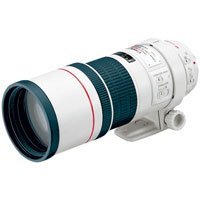
|
Canon EF 300/4L (IS) USM Review Optical Quality I've tested this lens alongside all the Canon 75-300 and 100-300 zooms, as well as the EF300/2.8L, and it's clear that it is a very good lens indeed. It is significantly sharper than the zooms (including the 100-300/5.6L) and holds its own against it's "big brother" the 300/2.8. It's sharp wide open and even sharper when stopped down to f5.6. I have no hesitation at all using this lens wide open. Image quality is very close to that of the 300/2.8L. I'd say that the 300/4 at f4 and the 300/2.8 at f2.8 are about equal, but at any given aperture the 300/2.8 has a slight edge. This is based on looking at images of resolution test targets. For real world images, it's pretty hard to tell which lens shot what. The 300/4L works very well with the Canon 1.4x TC. Again I have no hesitation about shooting wide open (420mm f5.6) with this combinations and I'm very happy with the results. Autofocus is still fast and accurate. In a side by side test of the 300/4L + 1.4x TC and a Sigma 400/5.6 APO (not the new Macro APO), the Canon lens combination was clearly better (sharper, higher contrast, more neutral color). I found that the EF300/4L + 1.4x TC also outperformed the EF 100-400/4.5-5.6L IS USM at 400mm With the Canon 2x TC you lose autofocus and some image quality. It's a usable 600/8, but I don't think this is a combination you would want to depend on if you were trying to make a living at photography and needed a 600mm lens to do it. Image quality is not as good as the EF 500/4.5L USM or the Ef 600/4L USM.
I have also tried the Tamron 1.4x TC with this lens. Results were pretty good, but not as good as with the Canon TC. Autofocus was less reliable, image quality was lower at the edges of
the frame and there was slight vignetting wide open when used with a full frame 35mm body. The slight vignetting is not visible with an APS-C sized DSLR (e.g. Digital Rebel (XT) or EOS 20D) FeaturesThe lens has a removable tripod collar, a built in sliding lens hood and a USM focus motor with full time manual overide. The front element (77mm filters) does not rotate during focusing. It's well balanced and solidly built (no plastic).Is it better than the Canon EF400/5.6L?From user reports, the 400/5.6L is equally sharp and focuses faster then the EF 300/4L + 1.4x TC, so it may be a better bet for moving subjects such as birds in flight. I can say though that, in principle, I like the 300/4 + TC combination better than the 400/5.6 + TC combination. With the 300/4 you get excellent 300/4 and 420/5.6 AF lenses. plus a usable manual focus 600/8. With a 400/5.6 you get an excellent 400/5.6 AF lens, a good, but manual focus, 560/8 and a very slow 800/11, which in my opinion isn't a very usable lens most of the time.SummaryThe EF 300/4L is a killer lens, espcially when combined with the Canon 1.4x TC. It's much better than any zoom I've ever tested at 300mm, and it's 1/2 the weight and 1/4 the price of the EF300/2.8L. It's the lens I take when I'm hiking around in areas where I expect to see wildlife but I don't want to carry too much weight. Not only is the lens pretty light (3lbs), but you don't need a monster tripod to support it either. I've had good results using it on a Bogen 3001 (3.5 lbs) with a medium Bogen ball head. You can't do that with the bigger telephotos. The 300/4 is an ideal compromise of size, weight, focal length, speed and costThe 300/4L USM Imaged Stabilized LensCanon currently produce only an IS (image stabilized) version of the 300/4L. The IS lens also has a shorter minimum focus distance then the non-IS did. The IS lens has 15 elements in 11 groups, while the original 300/4L has 8 elements in 7 groups. Adding elements can (though does not always) result in greater susceptibility to flare and/or loss of sharpness. Reports are that the 300/4L USM IS is a sharp lens. However the Popular Photography test (July 1997) seemed to show it was very similar in sharpness to the Sigma 300/4 APO Macro, while George Lepp's test of the original 300/4L showed it significantly sharper than the Sigma 300/4 APO Macro.My own tests show that sharpness is about the same with the two lenses, with the non-IS version having a very slight edge wide open. The IS lens is a little more prone to flare if you are shooting with the sun in the frame. If the IS function is important to you, these are secondary issues though. The IS lens would clearly outperform the non-IS version in any circumstances in which the IS function was needed (hand holding at slower shutter speeds). Where to BuyThe EF 300/4L (non IS version) is only available used. Currently (02/2005) you can expect to pay somewhere around $700 for one in good shape. Canon only currently manufacture the IS version, which sells for around $1150 new.
© Copyright Bob Atkins All Rights Reserved |
|